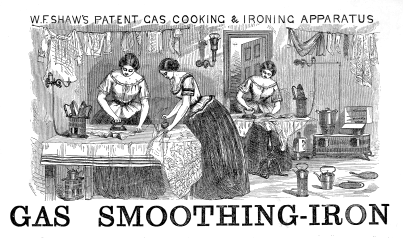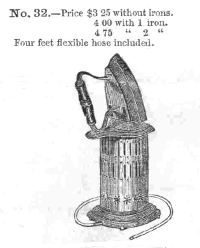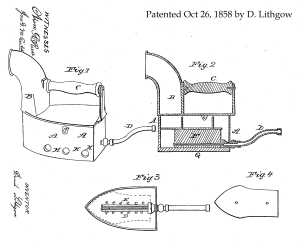-
History of:
- Resources about:
- More:
- Baby walkers
- Bakehouses
- Bed warmers
- Beer, ale mullers
- Besoms, broom-making
- Box, cabinet, and press beds
- Butter crocks, coolers
- Candle snuffers, tallow
- Clothes horses, airers
- Cooking on a peat fire
- Drying grounds
- Enamel cookware
- Fireplaces
- Irons for frills & ruffles
- Knitting sheaths, belts
- Laundry starch
- Log cabin beds
- Lye and chamber-lye
- Mangles
- Marseilles quilts
- Medieval beds
- Rag rugs
- Rushlights, dips & nips
- Straw mattresses
- Sugar cutters - nips & tongs
- Tablecloths
- Tinderboxes
- Washing bats and beetles
- Washing dollies
- List of all articles
Subscribe to RSS feed or get email updates.
Be it known that I, DAVID LITHGOW, of the city of Philadelphia and State of Pennsylvania, have invented a new and useful Improvement in the Construction of Flat-irons; ...
The object of my improvement is the employment of ordinary gas, introduced into the interior of the iron by a flexible tube, for the heating of the iron while used for smoothing purposes. Heretofore gas has been applied to flat-irons for such purposes by causing the gas to be thrown from the interior jets against the sides of the iron. In those irons is was also necessary to have side holes for the admission of air to support combustion and there was a constant tendency for the flame to escape through these side draft-holes, thus causing great risks to the person operating and to the articles being smoothed.
[From the 1858 patent]
A gas smoothing iron?
Ironing stoves, self-heating irons, and gas
 It's 1858 and you've just heard
of the wonderful, new self-heating irons. They're going to make life so much
easier: no more running backwards and forwards to a hot stove or fire to change
a cool flat iron for a freshly heated one, no more working in a roasting hot kitchen,
no more trying to keep fireplace ash off the irons. Some of the self-heating irons
use gas. Others carry little
tanks of alcohol or gasoline.
It's 1858 and you've just heard
of the wonderful, new self-heating irons. They're going to make life so much
easier: no more running backwards and forwards to a hot stove or fire to change
a cool flat iron for a freshly heated one, no more working in a roasting hot kitchen,
no more trying to keep fireplace ash off the irons. Some of the self-heating irons
use gas. Others carry little
tanks of alcohol or gasoline.
But is this really an ad for one of the new gas smoothing irons? Although that's what the headline offers, read on and you find it's really a "miniature gas furnace" with one or two gas burners for heating traditional flat irons. In fact, it's an ironing stove rather like the larger ones used by commercial laundries or tailoring businesses.
 Perhaps the ironing-stove set-up would be even better than a true gas iron? (See
patent drawing below right) The rubber hose connecting an iron to the only gas supply,
probably the new gas-light fitting, could be irritating or inconvenient for the
laundress. Perhaps the "four feet flexible hose" is better attached to
a small stove on the ironing table, than
to the iron itself? Then you can press clothes freely with nothing to restrict your
movements.
Perhaps the ironing-stove set-up would be even better than a true gas iron? (See
patent drawing below right) The rubber hose connecting an iron to the only gas supply,
probably the new gas-light fitting, could be irritating or inconvenient for the
laundress. Perhaps the "four feet flexible hose" is better attached to
a small stove on the ironing table, than
to the iron itself? Then you can press clothes freely with nothing to restrict your
movements.
The advertisement started:
Gas Smoothing-Iron, Cost of heating one iron is but one-twelfth of one cent. Time taken to heat one iron is four minutes. One pint water will boil in five minutes. Used by slipping the end of flexible hose over any gas burner. The most economical means yet known for heating irons.
and Miniature Gas Furnace.
W.F.Shaw's Patent
The only true principle, whereby all unpleasant and injurious odors are avoided. Warranted by far superior to any other invention for heating Smoothing-Irons ever offered to the public. [Boston, Massachusetts, 1858]
 W.F.Shaw also had an establishment in New
York, where they had won a bronze medal for their "gas heating parlor, and
cooking stoves, and gas flat iron heater" at the 1856 annual fair of the American
Institute.
W.F.Shaw also had an establishment in New
York, where they had won a bronze medal for their "gas heating parlor, and
cooking stoves, and gas flat iron heater" at the 1856 annual fair of the American
Institute.
David Lithgow of Philadelphia was one of the first inventors of a gas iron. See his 1858 patent drawing to the right, and an extract from the patent text in the left-hand column. Early gas irons were also produced by Siemens in England and Germany, among others.
More about gas irons and ironing:
- Self-heating irons with tanks for liquid fuel: kerosene, gasoline etc.
- Gas smoothing irons, petrol irons and other antique irons
- Gas and spirit irons
- 1940s John Wright 'Flow' gas iron
 20 March 2008
20 March 2008
You may like our new sister site Home Things Past where you'll find articles about antiques, vintage kitchen stuff, crafts, and other things to do with home life in the past. There's space for comments and discussion too. Please do take a look and add your thoughts. (Comments don't appear instantly.)
For sources please refer to the books page, and/or the excerpts quoted on the pages of this website, and note that many links lead to museum sites. Feel free to ask if you're looking for a specific reference - feedback is always welcome anyway. Unfortunately, it's not possible to help you with queries about prices or valuation.


